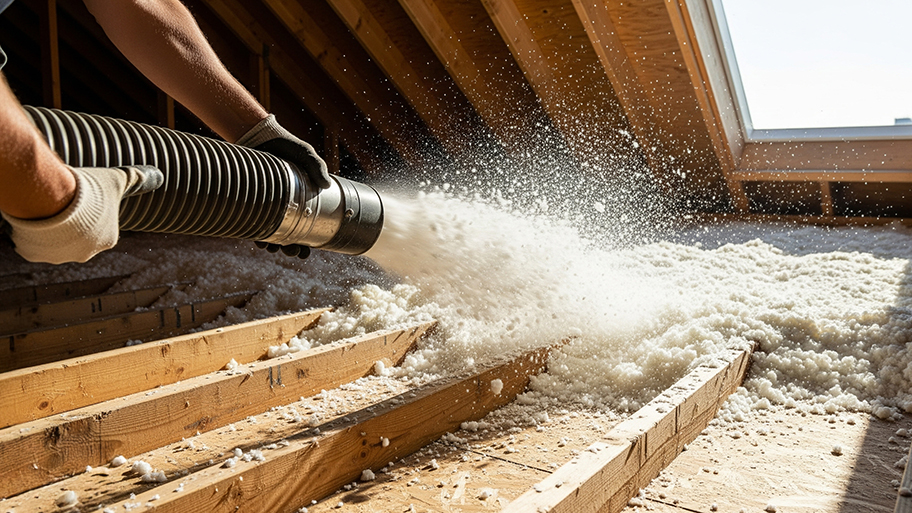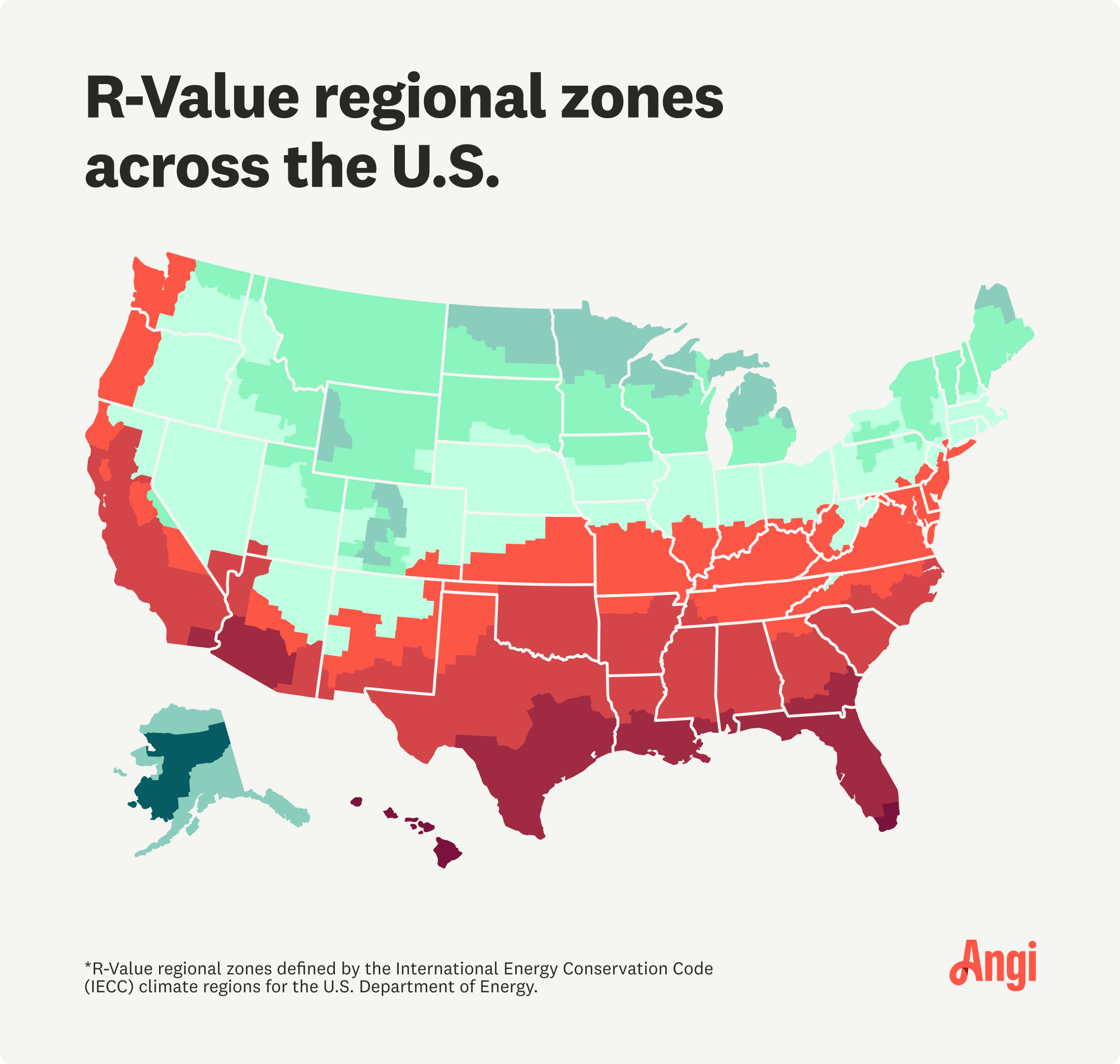
The cost of blown-in insulation costs varies depending on the type of insulation, labor, prep work, and more. Learn more about the cost factors in this guide.
Pay attention to R-value when selecting insulation for your home


R-value stands for "resistance value" and measures how well insulation resists heat flow.
Higher R-values provide better insulation to keep energy costs low.
Cold climates require higher R-value insulation than warmer climates.
Tax credits may be available to homes with higher R-value insulation.
Insulation is every homeowner's best friend when it comes to maintaining an efficient home. If your attic or walls need more insulation, it’s only a matter of time before you encounter a little letter “R” followed by a combination of numbers. What is an R-value, and how does it pertain to insulation? The R-value assigned to each type of insulation is an important qualifier you should understand before choosing some for your next project.
R-value stands for resistance-value, but what exactly are we “resisting?” For insulation purposes, R-value refers to how well insulation keeps hot air in or out of a home (or resists hot air). The higher the R-value, the better the insulation is at reducing energy loss. Depending on the season, you can use the R-value to predict how well your insulation will keep you nice and toasty or cool as an ice cube.
R-values are measured by inch of thickness. Typically, the higher the R-value per inch of thickness, the higher the cost of insulation.
There are four main types of home insulation, all of which have different R-values. These types include:
Fiberglass: 3.5–3.7 R-value per inch
Spray foam (open and closed): 3.5–7 R-value per inch
Loose-fill or blown-in cellulose: 3.5–3.7 R-value per inch
Mineral wool insulation: 3.0–3.3 R-value per inch

How high you need your R-value to reach depends mostly on your climate zone. U.S. zones range from one to eight, with one needing the lowest R-value for energy efficiency and eight needing the highest. Generally, the majority of the United States will fall into zones two through six, though there are a few exceptions to the rule.
For instance, the very southern tip of Florida and Hawaii will fall into zone one. Most of Alaska will fall into Zone Seven but veer into Zone Eight as they move north.

If your home needs new insulation or could benefit from an upgrade, a local insulation company will calculate the total R-value needed in your walls, attics, floors, and possible crawlspaces if you have one. This total R-value is not the listed R-value but the total amount of insulation your room needs to reach the recommended level.
For example, say you live in zone four, which typically recommends an R-value of around R38 to R60 for attic insulation. Rather than finding insulation with an R-value of R38 per inch of thickness, you simply need to have enough inches of insulation to equal the recommended R-value. If your attic has, say, 12 inches of room for insulation, you’ll need to source insulation with an R-value from R3.2 to R5, equating to a total R-value of R38.4 to R60.
The table below breaks down the general R-value recommendations based on climate zones.

Ideally, you’ll want to have insulation in all of the areas listed above and in your garage or ceiling (for those with two-story homes). A local pro can recommend the best type of insulation for your home if your existing materials aren’t getting the job done.
You’re not limited to only using one type of insulation, either. In fact, most homeowners looking to replace the insulation of their homes opt to stack the insulation for better climate control and energy efficiency.
According to Angi data, adding insulation to an existing home—whether that’s to a garage or the attic—accounts for over 80% of all batt and roll insulation projects. Often made of fiberglass, this type of insulation is easy to install since it comes in large sheets to fill large, open spaces.
If your home's insulation doesn't have the right R-value, there are ways you can increase the R-value to better insulate your home. Here are a few tips on how to increase the R-value of your insulation.
If you already have insulation installed, the first thing you want to do is inspect your existing insulation for tears, gaps, looseness, and sagging. Leaks in your insulation can quickly reduce the effectiveness of the insulation and decrease the R-value. Likewise, if you have a leak in your insulation in a moist location, this can let in water vapor that can also hinder your home’s insulation. Replace damaged insulation and close any gaps or holes to boost the R-value.
It’s not uncommon to reinforce fiberglass insulation throughout the walls of your attic with injection foam insulation to help fill in remaining gaps and increase your overall R-value. Just make sure to stay within recommended ranges so as to not overpay for insulation. You can also add more layers of batts and rolls or fill in gaps with blown-in insulation. Again, a local insulation company will work with your climate and suggest a course of action that’s best for your home.
For outdated insulation, you might be better off removing the insulation and replacing it with high-quality insulation with a high R-value. Rigid foam board insulation and structural insulated panels have some of the highest R values on the market, making them a great replacement option for walls.
Yes, there is a tax credit available through the Energy Efficient Home Improvement Tax Credit. According to ENERGY STAR, if you purchase and install insulation from January 1, 2023, through December 31, 2032, you can claim 30% off the cost of your insulation for up to $1,200.
Keep in mind that this tax credit applies to all energy property costs and eligible energy-efficient home improvements for a given year. If you make other energy-efficient home improvements in the same year—other than heat pumps, biomass stoves, or biomass boilers, then you won’t qualify for further savings. For this reason, it might be strategic to space out your energy-efficient projects for more than a year to maximize savings.
From average costs to expert advice, get all the answers you need to get your job done.

The cost of blown-in insulation costs varies depending on the type of insulation, labor, prep work, and more. Learn more about the cost factors in this guide.

Crawl space insulation costs vary by size, insulation type, and material. Read this guide to learn how much your crawl space insulation could cost.

New insulation can make your home more comfortable and boost energy efficiency. Use this insulation cost guide to get an accurate estimate for the installation.

There are 10 types of insulation you can use for your home. Read this guide to discover which insulation types could be best for the job.

When comparing fiberglass insulation versus foam board, each has certain areas where it works better. Learn more about these home insulation options.

How to decide if you should add insulation to your attic floor or ceiling to make your home more efficient